FREE SHIPPING when you spend $500+
Below $500: Flat rate of $14.99 for shipping.
Track Your OrderNeed Help? Call Us: 918-512-1281
- FOR THE DRIVER
- FOR THE PIT/SHOP
- FOR THE CAR
- GEAR & MERCH
Free shipping when you spend $500+
FREE SHIPPING when you spend $500+
Below $500: Flat rate of $14.99 for shipping.
Free shipping when you spend $500+
[The information provided is not intended to be medical advice. If you have questions, talk with your doctor.]
Motorsports, in addition to the physical aspects of the sport, is also mental. When on track our mind is fully immersed and occupied with one job – being as quick as the equipment will allow, and the sense of self-preservation. We want to drive home Sunday night safe, and our car looking pretty much the same as when we arrived Friday with maybe only the typical wear and tear on the usual stuff encountered over the course of a track weekend. In any sport or activity requiring precision, optimal mental focus and performance, hydration is critical! Only a 2% loss of water to body weight ratio can lead to a degradation of aerobic performance and cognitive ability. For a 200lb person, this is only 4lbs.
A worst case scenario: Consider you are approaching the brake zone of turn 1 at Road America. Regardless the car, this corner is after one of the longest straights in North America and you are carrying lots of speed. Worst case is you have a momentary loss of cognitive ability, forget where you are at that moment and forget to brake. Clearly a worst case scenario! Keeping ourselves properly hydrated won’t prevent this from happening, but does greatly lessen the chance of it happening. At Grattan years ago, I momentarily thought of what kind of tires I should get while on track, then I realized I had a job to do and had a corner coming up I needed to prepare for. Motorsports is highly mental as our mind and brain are continually working to solve problems while on track. Keeping ourselves properly hydrated while at the track over the entire weekend, and remaining conscious of staying hydrated, will help provide our body and mind what it needs to work to help us to be quick, and safe.
 At the 1982 Brazilian Grand Prix. Nelson Piquet collapses on the podium from heat exhaustion.
At the 1982 Brazilian Grand Prix. Nelson Piquet collapses on the podium from heat exhaustion.
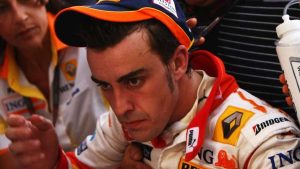
Fernando Alonso collapses in the media room following the 2009 Bahrain Grand Prix, His drink water pump failed early in the race and an overheating issue behind his driving seat left him extremely dehydrated and with a 1st grade burn on his back. He lost 11lbs during the race.
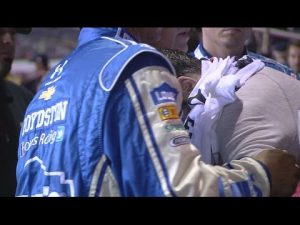
At the 2014 Federated Auto Parts 400 at Richmond International Raceway Jimmie Johnson is helped from his car because of dehydration and spent 90 minutes in the track care center where he received 5 liters of IV fluid.
These are elite drivers who are paid to drive and who have teams of doctors assisting them. For the “grassroots” driver who doesn’t have a team of doctors working for him/her, and who don’t typically tend to maintain a healthy diet, the consequences of excessive heat and fluid loss are exacerbated.
Our normal core body temperature is between 96.8F and 100.4F, with the average being 98.6F. Small increases in body temperature can help us to function more smoothly. Consider a car that is warmed up, oil is hot and lubricating as it should, everything is working to the optimal. Beyond 104F however, we begin to have physiological, cognitive and performance degradation. The engine is getting too hot! The issue is that the rate of body temperature is faster as ambient (outside) air temperature increases. (i.e. the hotter we get, the faster we get hot).
The image below shows the source of Heat In and Heat Out inside a racing vehicle.
Heat In is radiant heat from the sun, ambient cockpit air temperature and heat from the hot floor tunnel.
Heat Out is from an air ducted helmet or a Cool-Shirt type system, and if the suit can breathe and release body heat.
Sweat accounts for 80% of heat loss during exercise or performance.
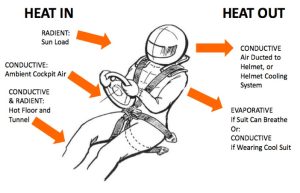
Our goal is to maintain fluid balance. As we perform a strenuous activity fluid loss will turn from urine to sweat. To be blunt, we want to make sure we are peeing frequently at the track.
We need to start our hydration plan before we arrive at the track. For optimal health in general it is recommended to drink about half our body weight in ounces of water. For a 200lb person this is about 100oz. This is relatively easy to accomplish. Most water bottles are 24oz, so this is 4 of those a day. Two before lunch and two after lunch.
Your hydration should start the day before your first event. You can accomplish on the drive to the track Friday before your first event on Saturday. Have some bottles of water in the truck and drink them on the drive to the track. You’re set and started your hydration for the weekend!
Yes, you’ll be peeing frequently, this is good.
Add an ice chest with water to the checklist you make for packing your track/trailer for the weekend.
During the weekend plan to have a bottle of water with you or near you at all times. All through the day make note to have at least one open bottle of water with you or near you at all times that you are working on. Remain conscious of “working on a bottle of water” the whole weekend.
After your session we need replenish what we’ve lost, this is fluids and electrolytes. Electrolytes are essential for the condition of electrical energy between and within cells. for maintaining cognitive function (decision-making), communication between nerves and muscles (reaction time) and for muscle contraction itself. Sodium is lost from sweat and is the most crucial electrolyte to replenish to help ensure we are operating at peak performance.
Some good products to consume post session:
Gatorade contains primarily carbohydrates but do contain electrolytes and has been proven to boost performance for activities lasting longer than 1 hour. Just don’t make Gatorade your only drink for the weekend. Follow it up with some water.
Avoid energy drinks such as Red Bull and Monster. These are primarily “lifestyle drinks” and contain lots of sugar. Limit or eliminate soda pop or fountain drinks for the weekend. Drink water during the break for lunch.
The chart shown is a good reference to see if you are properly hydrated. When you urinate check the color of your urine. The more clear it is, the better. If its yellow, drink more water. Make note: if you take a multi-vitamin your urine may be more yellow as your body evacuates vitamins it doesn’t need.
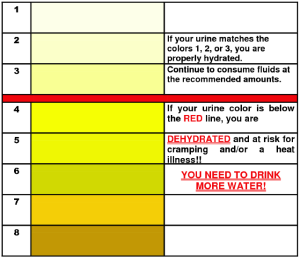
The image below shows some consequences of excessive heat and fluid loss.
At the track pay attention to these symptoms from you or anyone else at the track. Crew, spectators, corner workers. Anyone else at the track with you that day. We are here to look out for one another!
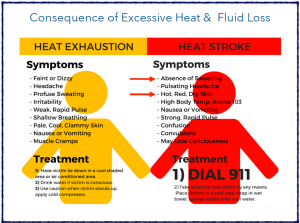
Thanks to Dr. Edward S. Potkanowicz, ACSMEP-C of Ohio Northern University (Racinggoessafer.org) for much of the information in this content. This material was presented at a seminar at the 2019 PRI show in Indianapolis.
Lastly, have fun! Motorsports is fun!
***
Call To Grid was created to serve the grassroots racer! We offer only the most premier brands for the driver, car, and shop to help keep you safe, looking good and on the podium! We develop original content to help you and the car find speed! We know why you race; it’s the desire, discipline and determination required to do something well. It’s the camaraderie you experience at the track with people who share this passion of motorsports! Join us at Call to Grid to join the community of passionate drivers like yourself today!